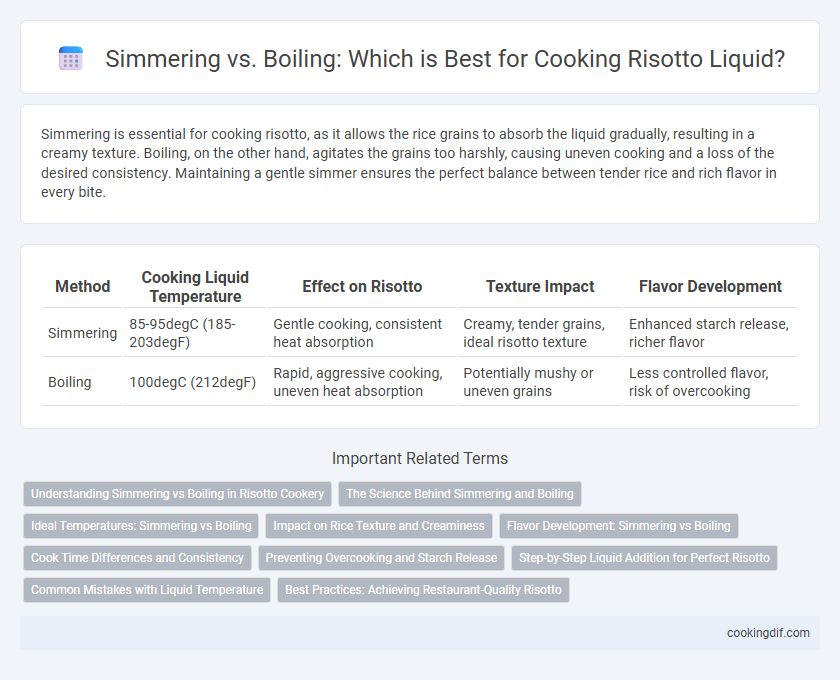Simmering is essential for cooking risotto, as it allows the rice grains to absorb the liquid gradually, resulting in a creamy texture. Boiling, on the other hand, agitates the grains too harshly, causing uneven cooking and a loss of the desired consistency. Maintaining a gentle simmer ensures the perfect balance between tender rice and rich flavor in every bite.
Table of Comparison
| Method | Cooking Liquid Temperature | Effect on Risotto | Texture Impact | Flavor Development |
|---|---|---|---|---|
| Simmering | 85-95degC (185-203degF) | Gentle cooking, consistent heat absorption | Creamy, tender grains, ideal risotto texture | Enhanced starch release, richer flavor |
| Boiling | 100degC (212degF) | Rapid, aggressive cooking, uneven heat absorption | Potentially mushy or uneven grains | Less controlled flavor, risk of overcooking |
Understanding Simmering vs Boiling in Risotto Cookery
Simmering in risotto cookery allows the rice to absorb liquid gradually, ensuring a creamy texture by maintaining gentle heat just below boiling point. Boiling can cause the liquid to evaporate too quickly and the rice to cook unevenly, resulting in a grainy or mushy consistency. Mastering the delicate balance of simmering preserves the starch release critical for the signature velvety finish of traditional risotto.
The Science Behind Simmering and Boiling
Simmering maintains a temperature between 185degF and 205degF, allowing gentle convection currents that evenly cook the rice and release starch slowly for a creamy texture in risotto. Boiling at 212degF causes rapid agitation that can break grains apart and lead to uneven cooking, disrupting the delicate starch gelatinization crucial for risotto's characteristic creaminess. Controlling the heat to sustain a simmer ensures gradual liquid absorption and optimal al dente consistency, enhancing flavor extraction and the overall mouthfeel.
Ideal Temperatures: Simmering vs Boiling
Simmering at temperatures between 185degF to 205degF (85degC to 96degC) is ideal for risotto, ensuring gradual absorption of broth and creamy texture development. Boiling, which occurs above 212degF (100degC), can cause uneven cooking and grain breakage, resulting in a mushy consistency. Maintaining a gentle simmer preserves the rice's al dente firmness and enhances flavor integration during the cooking process.
Impact on Rice Texture and Creaminess
Simmering risotto ensures gradual absorption of liquid, preserving rice's al dente texture and promoting creamy starch release. Boiling causes rapid liquid absorption, leading to uneven cooking and a mushy, less creamy consistency. Controlled simmering maintains optimal starch gelatinization, resulting in a richer, velvety risotto texture.
Flavor Development: Simmering vs Boiling
Simmering risotto allows gradual flavor infusion as the cooking liquid gently penetrates the rice, enhancing the dish's depth and richness. Boiling risks evaporating delicate aromatics and can cause uneven cooking, diminishing the subtle nuances essential to authentic risotto. Maintaining a steady simmer preserves the broth's complexity, ensuring a harmonious balance of flavors throughout the dish.
Cook Time Differences and Consistency
Simmering risotto allows for gradual absorption of liquid, resulting in a creamy consistency and evenly cooked grains, typically requiring 18 to 20 minutes of cook time. Boiling accelerates liquid evaporation but risks uneven cooking and a less cohesive texture, often shortening cook time to around 12 to 15 minutes. Maintaining a gentle simmer ensures optimal starch release, crucial for the signature velvety texture of risotto.
Preventing Overcooking and Starch Release
Simmering the cooking liquid in risotto ensures gradual starch release from the rice, creating a creamy texture without causing the grains to break down. Boiling the liquid can lead to rapid starch release and uneven cooking, increasing the risk of overcooked, mushy risotto. Maintaining a gentle simmer preserves the rice's al dente integrity while promoting optimal creaminess.
Step-by-Step Liquid Addition for Perfect Risotto
Simmering the cooking liquid is crucial for step-by-step addition in risotto, as it maintains a consistent temperature that allows the rice to absorb flavors evenly without disrupting the cooking process. Gradually adding hot liquid while stirring encourages the release of starch from Arborio or Carnaroli rice, resulting in the signature creamy texture. Boiling the liquid can shock the rice, leading to uneven cooking and a less cohesive dish, so maintaining a gentle simmer ensures optimal risotto consistency.
Common Mistakes with Liquid Temperature
Using boiling liquid instead of simmering when preparing risotto can cause uneven cooking and a grainy texture. Simmering maintains a consistent gentle heat, allowing the rice to absorb liquid gradually and release starch for a creamy result. A common mistake is adding liquid too hot or rapidly, which disrupts the cooking process and prevents proper starch gelatinization.
Best Practices: Achieving Restaurant-Quality Risotto
For restaurant-quality risotto, maintaining a gentle simmer rather than a rolling boil is essential to achieve creamy texture and even cooking. Simmering allows the Arborio rice to absorb the broth gradually, preventing the grains from breaking apart and ensuring perfect al dente consistency. Constant stirring combined with carefully controlled heat maximizes starch release, resulting in the classic velvety finish chefs strive for.
Simmering vs Boiling for cooking liquid Infographic

 cookingdif.com
cookingdif.com